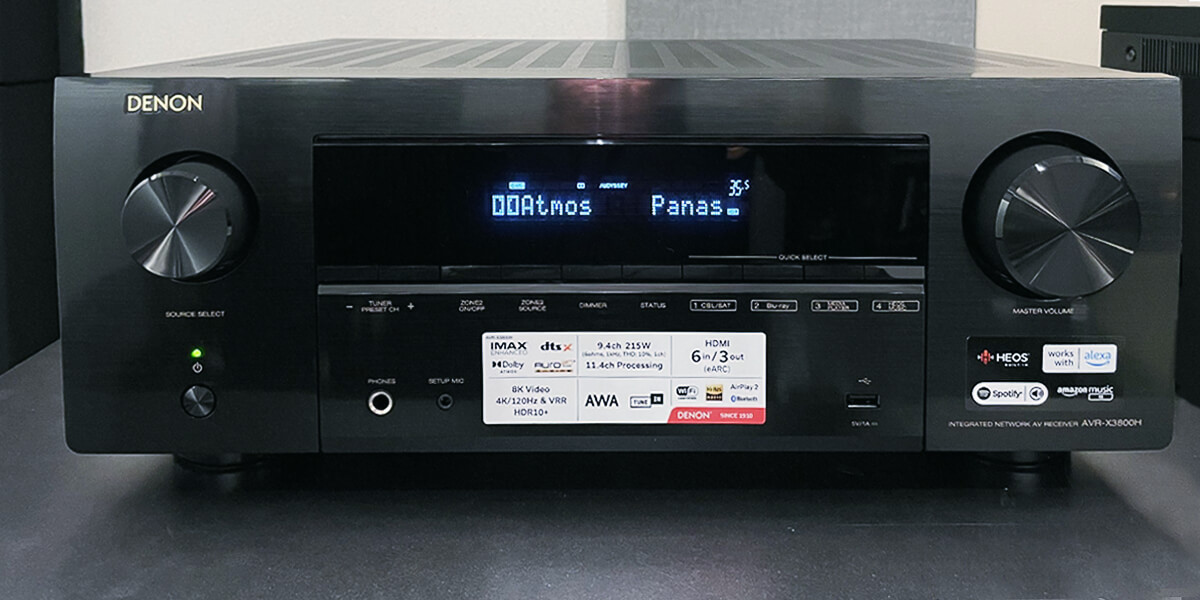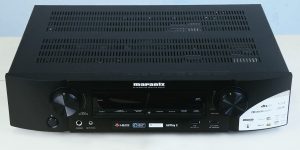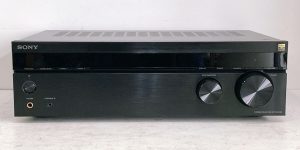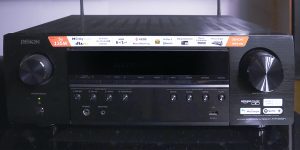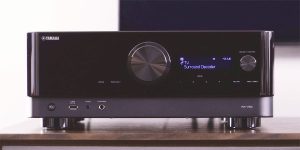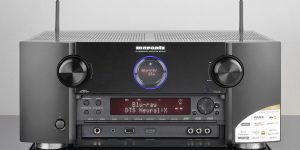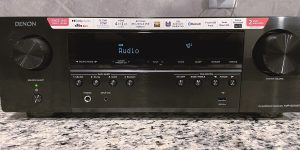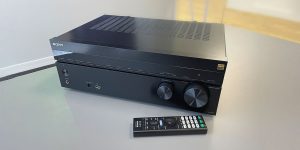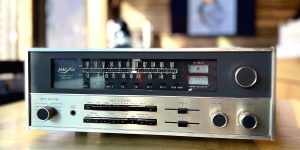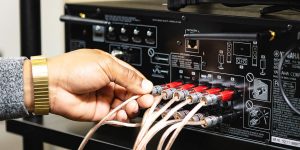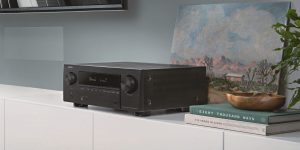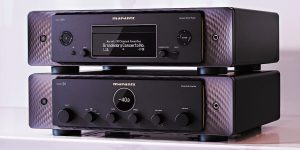Dolby Atmos technology burst into the world of movie theaters quite a long time ago but still holds a strong leading position. So it’s no surprise that home theaters have also become “victims” of this most popular surround sound format. Speaking about choosing the best Dolby Atmos receiver, it should be noted that modern receivers of even the most budget segment can support this format (starting from 7 amplifier channels), but I decided to consider a more expensive but the most acceptable option for most of us – the middle-price category. So, we will talk about receivers with full Atmos support, which will give you a sense of immersion in the events on the screen and give you quality and functionality for years to come. In my review, I’ll also tell you what you need for a receiver that supports this immersive format, what configurations you can build for a more complete experience, and answer some common questions. Time dictates its rules, and we just have to stay on trend!
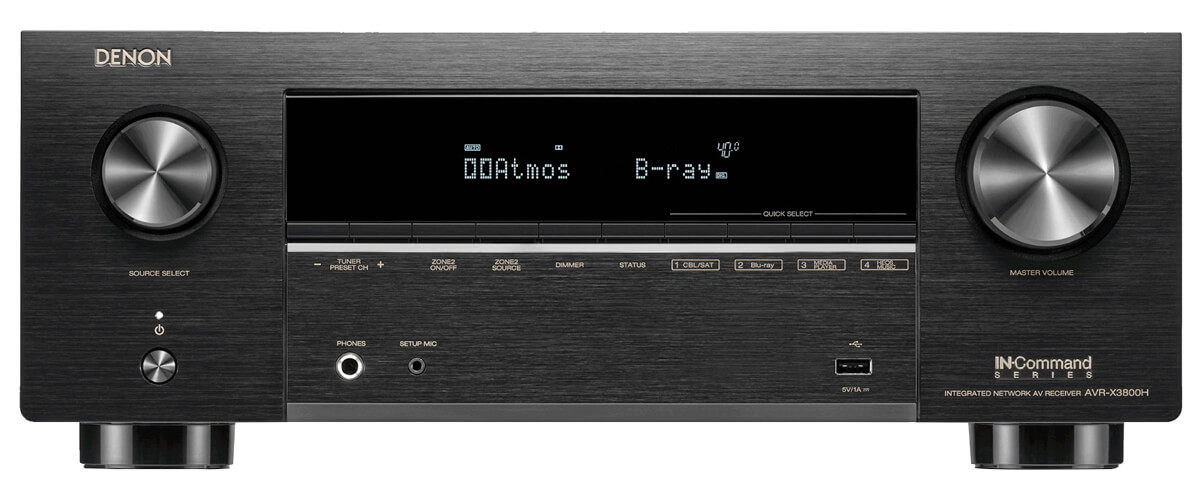
Dolby Atmos receivers comparison table
| Name | Channels | Power output | HDMI in/out | Bluetooth/Wi-Fi | Review |
|---|---|---|---|---|---|
| Denon AVR-X3800H best overall | 9.4 | 105W/8 Ohm, 135W/6 Ohm | 6/3 | yes/yes | Review |
| Onkyo TX-RZ50 also great | 9.4 | 120W/8 Ohm | 7/2 | yes/yes | Review |
| Pioneer Elite VSX-LX505 | 11.2 | 120W/8 Ohm, 230W/6 Ohm | 7/2 | yes/yes | Review |
| Onkyo TX-NR696 mid-price | 7.2 | 100W/8 Ohm, 210W/6 Ohm | 7/2 | yes/yes | Review |
Why is a Dolby Atmos receiver necessary?
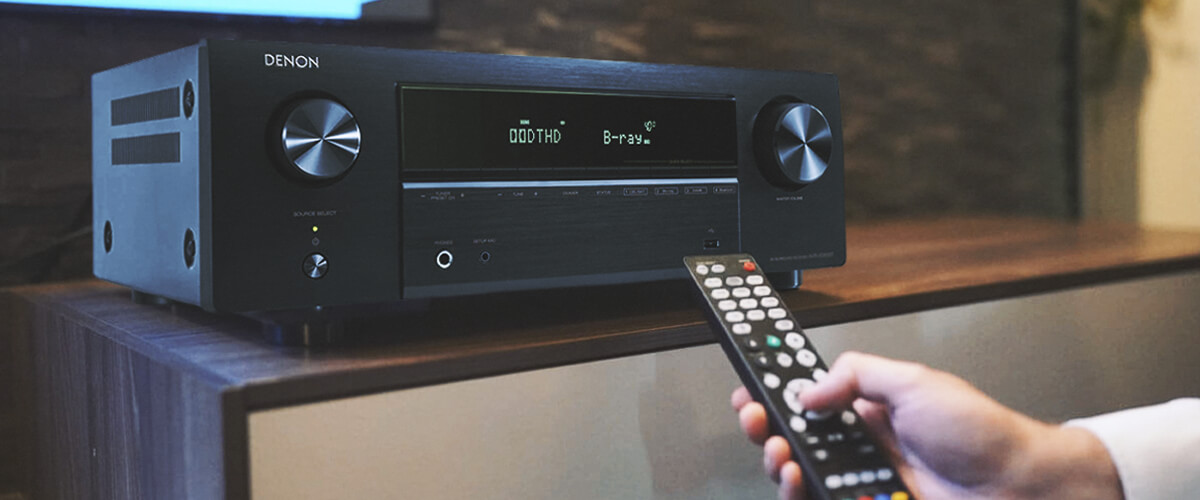
AVR with Dolby Atmos, unlike a standard receiver, can decode the soundtrack of this surround sound format, which means that you will hear the author’s original idea. The standard receiver allows you to view content with an Atmos audio sequence, but you do not hear all the versatility and colorfulness of the overall sound picture.
Given the uniqueness of object-oriented audio signal distribution, each sound must reach its definitely intended point in space. It is what makes it so real and gives a feeling of “presence”.
Best Dolby Atmos receiver reviews
Denon AVR-X3800H – best overall

Denon receivers often occupy the leading position in my selections, and this rating is no exception. AVR-X3800H combines a fairly acceptable price (although it is the most expensive on the list), quality worthy of premium models, and the sound most suitable for most of us – clean, clear, bright, and dynamic. Watching Dolby Atmos movies with it is a pleasure. All the more so because with the initial ability to amplify 9 channels, with the addition of an external amplifier and 2 additional subwoofers, you can build a system of 11.4 – optimal for a large house with a spacious living room, so that each soundtrack reaches its place in it. But the Denon is also great with music, especially with vinyl (there is a phono input with a good phono stage).
The power output of the AVR-X3800H is not too great at 105 watts (8 ohms, 20Hz – 20kHz, 0.08%, 2ch). So, if you prefer your windows and the chair under you to shake when watching action scenes – there are more powerful options in my rating. But the sound is clear even at high volume, and I like the overall soundstage. Another “lag” from the other review models is that the multi-room is only for 2 zones.
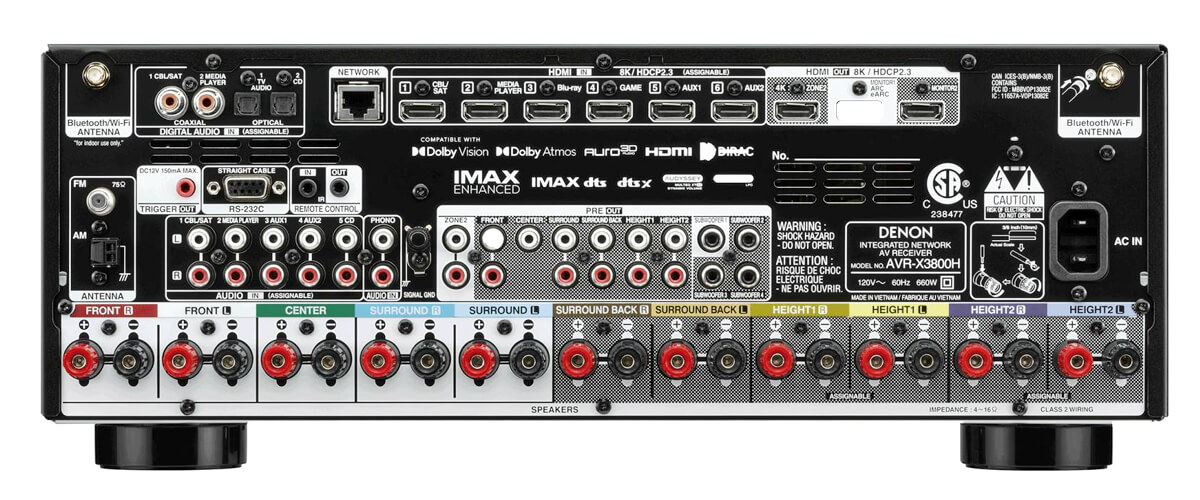
Although the receiver was released in 2022, and its HDMI ports have version 2.1 to stream 8K video (4K for Zone 2), they are few for such a system (only 6/3). In any case, you can watch any content today from various sources and play with all modern consoles. The signal translation, as well as the picture itself, is excellent and adds to the experience when watching movies.
The AVR-X3800H has the widest wireless connectivity (dual-band Wi-Fi and Bluetooth 4.2, AirPlay 2, and built-in HEOS), which works with most streaming services and voice assistants. I won’t dwell on describing how they work since I’ve already mentioned that the AVR is versatile for multichannel and stereo sound. Its DAC handles a 384 kHz/32-bit signal.
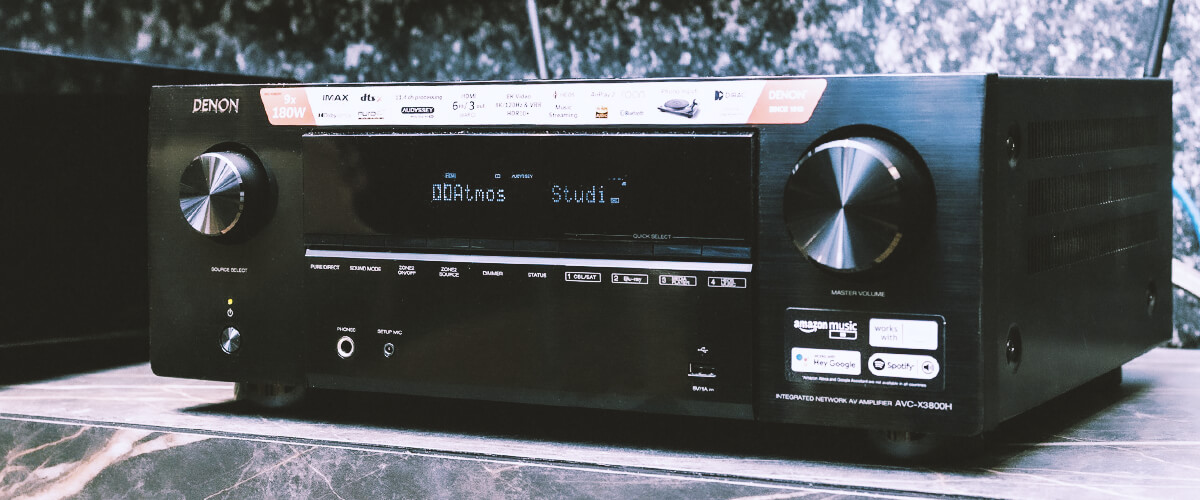
In addition to Dolby Atmos, the receiver decodes DTS:X and features IMAX Enhanced, 360 Reality Audio, and Auro 3D. I really like how smoothly the sound transitions from one speaker to the next, creating near-perfect realism. If you close your eyes, it’s quite possible to believe you’re in the middle of a crowd in an airport lounge or on the street, stunning layering. I also really appreciate the Audyssey MultEQ XT32’s autocalibration, which, for inexperienced users, can be pure salvation because it requires almost no intervention from you, analyzing even the specifics of the room.
Denon AVR-X3800H – the best 9.2 Dolby Atmos receiver, with which you can expand the system up to 11.4 channels, wide possibilities of wired and wireless connection, and support for modern surround sound and video formats. With it, you will not have to think about upgrading your system, and its warm sound will accompany your leisure time, whether it is watching movies, playing on a console, or listening to stereo.
Key specs
- Channels: 9.4.
- Power output: 105W/8 Ohm, 135W/6 Ohm.
- HDMI inputs/outputs: 6/3.
- Video functions: 8K/60Hz, 4K/60Hz, 4K/120Hz, upscaling to 8K.
- Bluetooth/Wi-Fi: yes/yes.
- Streaming services: AirPlay 2, Spotify, TuneIn, Deezer, Tidal, Netflix, Amazon Prime.
- Supports: HDMI ARC, HDMI eARC, HDMI CEC, HDCP2.3, HDR10+, Dolby Vision, 3D Signal Pass-through.
- Surround sound: DTS:X, DTS Neural:X, DTS Virtual:X, Dolby Atmos, DTS HD Master, Dolby TrueHD, Dolby Atmos Height Virtualization, IMAX Enhanced.
Pros
- It is possible to build an optimal system for Dolby Atmos 11.4 (with added components), the maximum in my rating.
- Clean, bright, and dynamic sound, ideal for movies and music.
- Supports the highest video and surround sound quality available today and won’t need upgrading for long.
- Wireless capabilities are virtually unlimited.
- Creates a near-perfect realistic soundscape.
- Audyssey MultEQ XT32 calibration is optimal if you don’t want to mess around with manual adjustments.
Cons
- It’s not the most powerful in my selection.
- Unlike the other receivers on this list, Multiroom is only for 2 zones.
- Not enough HDMI ports.
Onkyo TX-RZ50 – also great
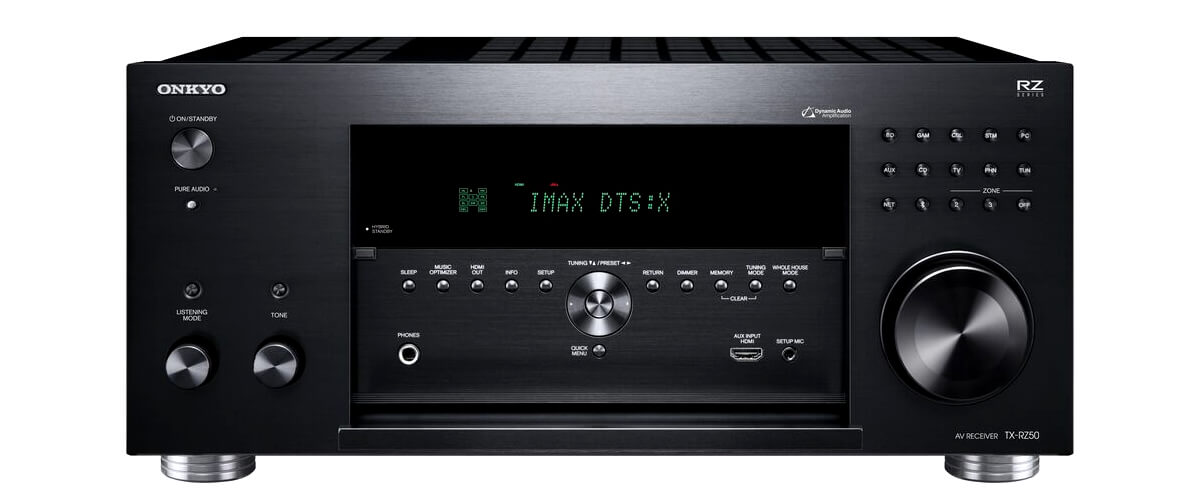
A lower-cost alternative is the 9.2-channel Onkyo TX-RZ50. It is more powerful than AVR-X3800H – 120 W (8 Ohms, 20 Hz – 20 kHz, 0.08% THD, 2 ch), and with it, the system can also be expanded to 11 channels, but in this case only with 2 subwoofers. The differences between the two models presented are not too striking, but still, Onkyo always offers more functionality, sacrificing the quality of internal components. Nevertheless, rest assured you are buying a good device for this price segment.
The TX-RZ50 is also a modern device with great connectivity options. Being released in 2021, it has 7/2 HDMI ports with support for 8K video (like the AVR-X3800H), and you also have access to all the joys of version 2.1, including eArc audio, HDCP 2.3 protection, and gaming features. The receiver also streams video to Zone 2, but at up to 8K resolution, and audio for Zone 3. And that’s what I was talking about – more features at a lower cost.
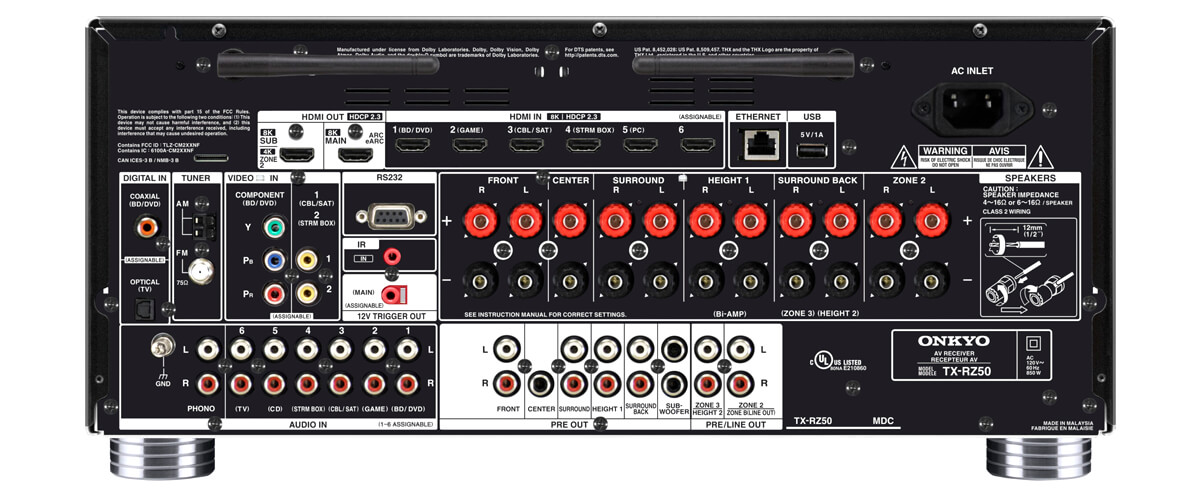
There are advantages to wireless music streaming as well. For example, the receiver has support for DTS Play-Fi operation, which holds signal strength better, and its Bluetooth supports AAC and aptX HD codecs (iOS and Android), which also improves the stability of this kind of connection. Multi-room audio is available with AirPlay 2 and Chromecast, and the device is also compatible with Sonos (the AVR-X3800H is not). You can access most streaming services, but Hey Google or Alexa voice assistants will only become available after you purchase an additional device. That is, obviously, some compromises at an undervalued relative to Denon’s price – there are.
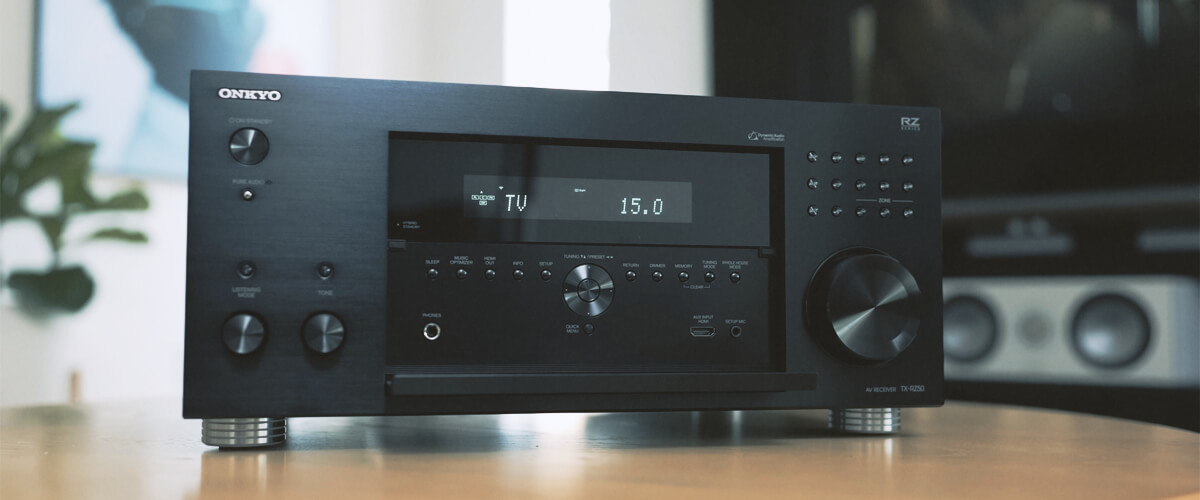
To complete a TX-RZ50 review, I must describe my impressions from listening to surround sound formats. So, everything is clear with Dolby Atmos, but in addition to it, there is an opportunity to decode DTS:X, for which IMAX Enhanced technology is implemented, but not Auro 3D. Also, the receiver has THX Certified Select, which speaks of high-quality surround sound and marks all the most advanced models. So, with all these “charms,” AVR provides a great sound picture and balanced distribution of soundtracks; you can also improve the level of dialog. But for me, it loses out to the Denon. Of course, this might sound too subjective if people who know about sound don’t agree with me. Nevertheless, the difference will not be so noticeable for the average viewer.
Onkyo TX-RZ50 rightfully takes second place in my rating. This beautiful 7.2.4 Atmos receiver will become a universal entertainment even if you have a large family with different preferences because it provides video and audio broadcasting to different rooms, has wireless multi-room technologies, and along with some compromises relative to the leader, it is still a quality receiver.
Key specs
- Channels: 9.2.
- Power output: 120W/8 Ohm.
- HDMI inputs/outputs: 7/2.
- Video functions: 8K/60Hz, 4K/120Hz pass-through, upscaling to 8K.
- Bluetooth/Wi-Fi: yes/yes.
- Streaming services: AirPlay 2, Spotify, TuneIn, Deezer, Tidal, Netflix, Amazon Prime.
- Supports: HDMI ARC, HDMI eARC, HDMI CEC, HDCP2.3, HDR10+, Dolby Vision.
- Surround sound: DTS HD Master, DTS:X, DTS Neural:X, Dolby TrueHD, Dolby Atmos, Dolby Atmos Height Virtualization, Dolby Surround, IMAX Enhanced.
Pros
- Powerful, clean sound for an 11.2 system (more power than the selection leader).
- Multiroom for 3 zones, unlike the AVR-X3800H.
- Support for DTS Play-Fi Ready and Bluetooth codecs AAC and aptX HD improves the stability of wireless signal transmission.
- THX Certified Select certification means high-quality sound.
- Stable streaming of video, multichannel, and stereo signals.
Cons
- You must purchase a separate unit to use voice assistants.
- Does not support Auro 3D surround sound format.
- The overall sound picture is inferior to the leader of the selection.
Pioneer Elite VSX-LX505
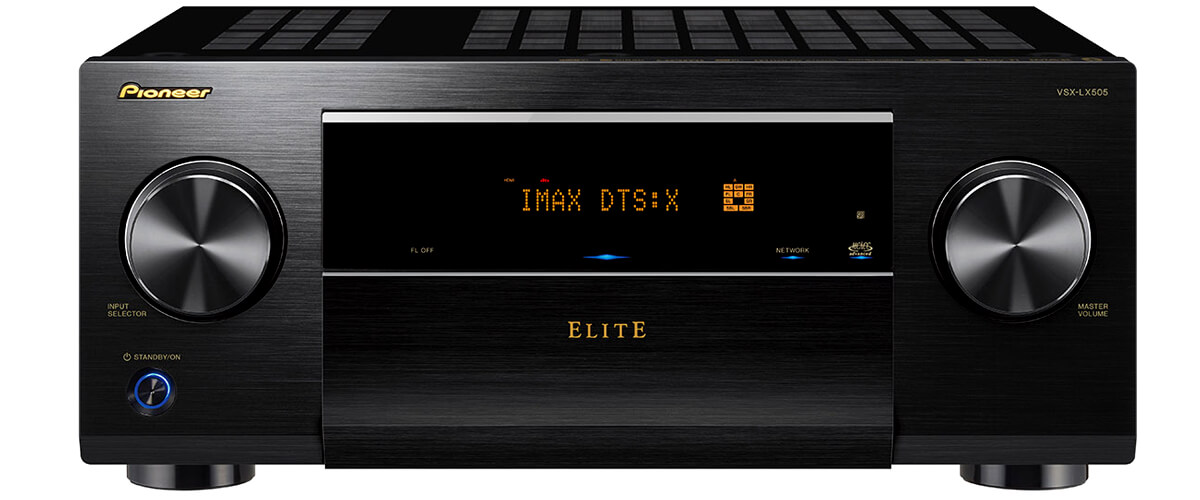
The third, but essentially the same alternative 9.2-channel receiver in my chart, is the Pioneer Elite VSX-LX505. It’s very similar to the Onkyo TX-RZ50: it’s almost identically priced and provides similar functionality. For example, you can also build an 11.2 system with 120 watts of power (8 Ohms, 20Hz-20kHz, THD 0.08%, 2ch).
Identical number of HDMI connectors (7/2), 6 inputs of which are version 2.1. I don’t even know what else to add because I described everything in the previous review. Perhaps we can mention that all three receivers support HDR10, HDR10+, and Dolby Vision video formats, which I didn’t mention earlier. All in all, it is a modern 2021 AVR with full support for video content that exists today.
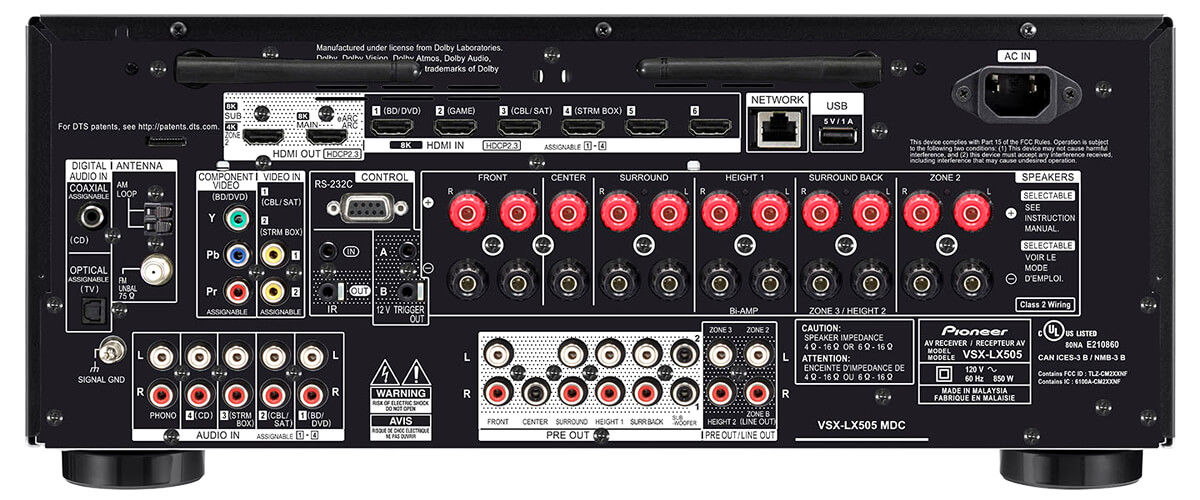
You get a worse DAC than the Denon AVR-X3800H, capable of handling 192 kHz/24-bit signal. But… surprise! Onkyo is only capable of doing this, too. They even have a completely identical set of wireless connectivity, and I didn’t notice any difference in their performance. The connection is stable, and there are no annoyances. Perhaps worth mentioning is the very simple and easy-to-use Pioneer Music Control App that made managing multi-room audio a pleasure.
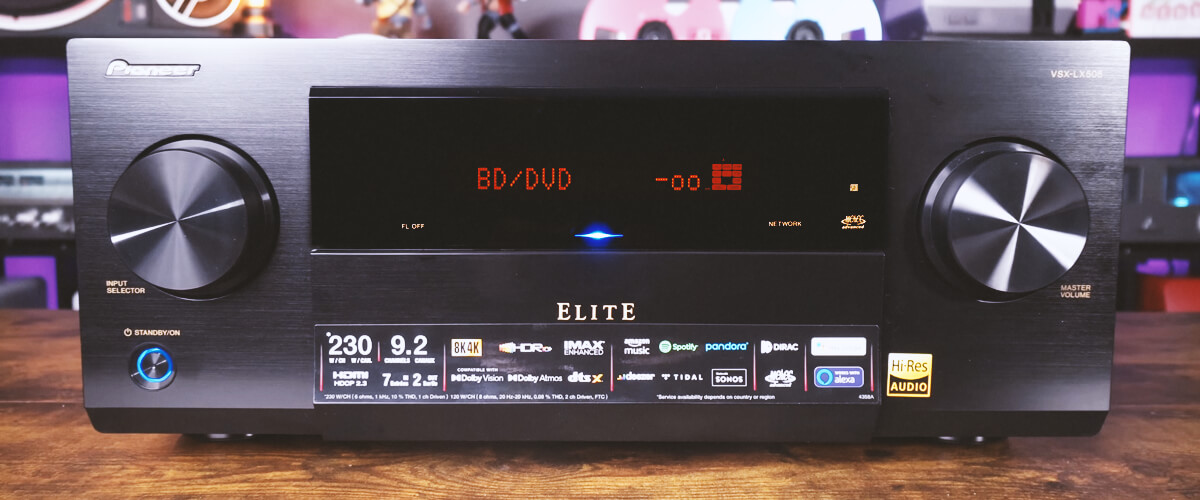
Home theater receiver with Dolby Atmos has multi-room for 3 zones and decodes surround sound formats identical to TX-RZ50; that is, it does not support only Auro 3D (of the most popular). And it sounds good, although somewhat different from Onkyo’s sound. But here, the choice will be purely up to you, taking into account your personal preferences. I always recommend listening to the receiver before buying if you have the opportunity. It is worth noting separately the absolutely primitive MCACC calibration system. However, the manufacturer has equipped VSX-LX505 with an advanced Dirac Live sound correction system. If you spend time on it because it is complex, you can bring the system’s sound to the optimal level.
Home theater receiver with Dolby Atmos has multi-room for 3 zones and decodes surround sound formats identical to TX-RZ50; that is, it does not support only Auro 3D (of the most popular). And it sounds good, although somewhat different from Onkyo’s sound. But here, the choice will be purely up to you, taking into account your personal preferences. I always recommend listening to the receiver before buying if you have the opportunity. It is worth noting separately the absolutely primitive MCACC calibration system. However, the manufacturer has equipped VSX-LX505 with an advanced Dirac Live sound correction system. If you spend time on it because it is complex, you can bring the system’s sound to the optimal level.
Key specs
- Channels: 11.2.
- Power output: 120W/8 Ohm, 230W/6 Ohm.
- HDMI inputs/outputs: 7/2.
- Video functions: 8K/60Hz, 4K/120Hz pass-thorugh, upscaling to 8K.
- Bluetooth/Wi-Fi: yes/yes.
- Streaming services: AirPlay 2, Spotify, TuneIn, Deezer, Tidal, Netflix, Amazon Prime.
- Supports: HDMI ARC, HDMI eARC, HDMI CEC, HDCP2.3, HGL, HDR10, HDR10+, Dolby Vision.
- Surround sound: DTS:X, DTS Neural:X, Dolby Atmos, DTS HD Master, Dolby Atmos Height Virtualizer, Dolby TrueHD, Dolby Digital Plus, IMAX Enhanced, Dirac Live.
Pros
- The Pioneer Music Control App makes controlling multi-room wireless audio much easier.
Cons
- The DAC processes only 192 kHz/24 Bit signal, worse than the leader Denon AVR-X3800H.
- MCACC room correction system is primitive, while Dirac Live is complex.
Onkyo TX-NR696 – mid-price
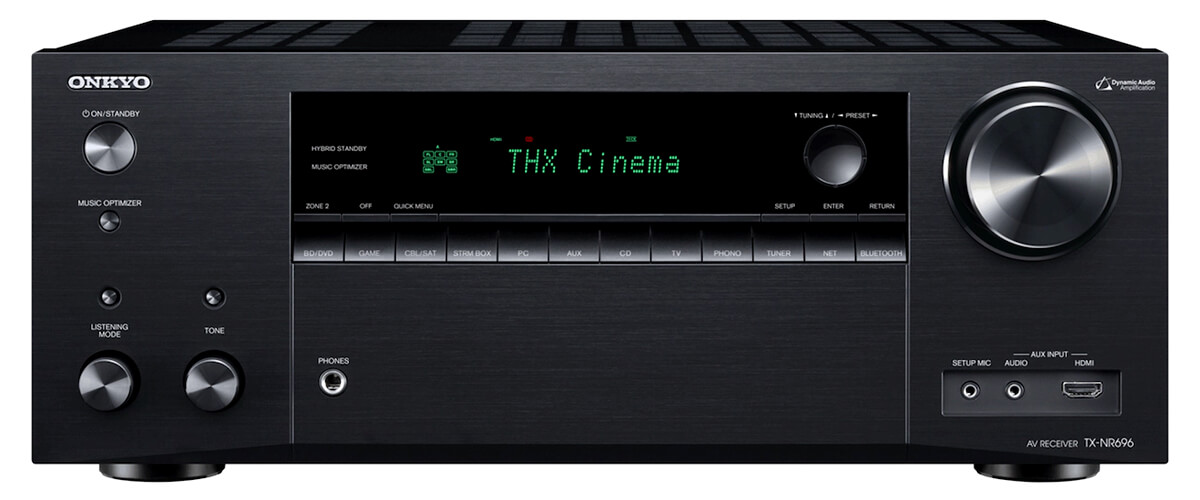
If you want an Atmos receiver but don’t want to place the system all over the room and are ready to be satisfied with a minimal but full-featured 5.2.2 configuration while reducing the cost of buying the device by 3 times, then I’m ready to introduce you to Onkyo TX-NR696. The 7.1 AVR with 100 watts (8 Ohms, 20-20 kHz, 0.08%, 2 ch) is more suitable for an apartment or a small living room up to 300 square feet; its sound is also good with another DTS: X surround format, but stereo lovers will be satisfied too. So, once again, we have a versatile receiver.
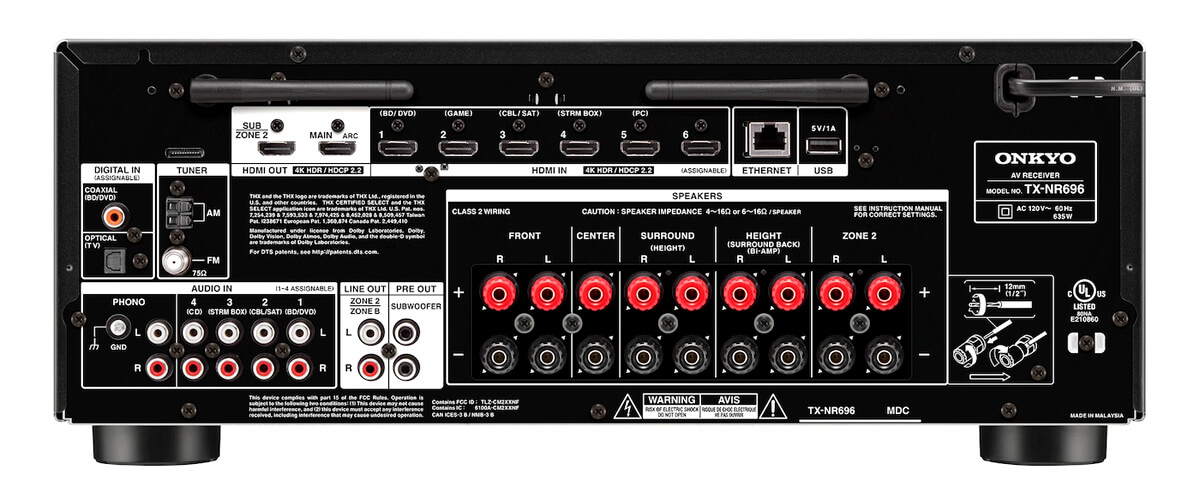
The TX-NR696 was released in 2019, and there was no HDMI 2.1 back then, so it’s only able to pass through and upscale 4K/60Hz video. But if you’re not looking to pluck all the cherries off the cake, you’ll be quite satisfied with it, as most content today is released in this quality. But it has 7/2 HDMI ports, the same number as the other rating participants. For a 7-channel device, this is very good! It’s not without drawbacks. When using the HDMI ARC, I noticed some minor audio and video desynchronization, which I fixed by rebooting or changing the port.
Wireless connections are a bit inferior to the 9-channel “competitors” of my selection, but I was quite satisfied with them. There’s Wi-Fi, DT Play-Fi and AirPlay2, and Chromecast multi-room audio. Bluetooth capabilities are simpler, but it does a pretty good job of broadcasting and holding a signal, especially with my iPhone, as it supports the AAC codec.
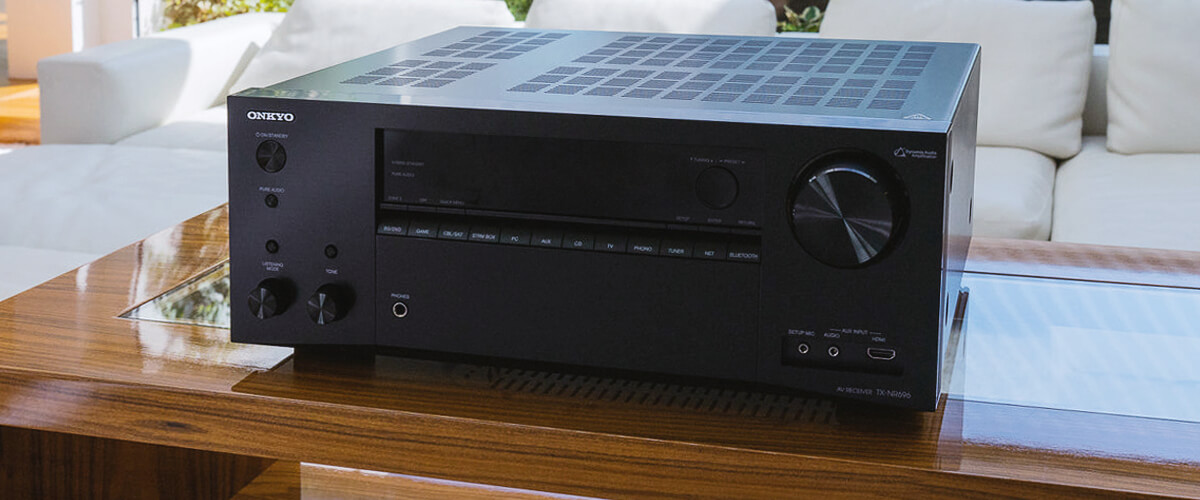
I was pleasantly surprised that this Onkyo model is also THX Certified, like the brand’s more expensive models. And its DSP amplifier has 384kHz/32-bit signal processing, like my rating leader, the Denon AVR-X3800H. Even with virtual immersive formats, the sound is quite convincing, and the details are audible very well. Plus, the multi-room video and audio feature is possible on two screens in different rooms.
Onkyo TX-NR696 is the best-budget Dolby Atmos receiver. Its price and functions make it belong to the middle segment, which means it can rightfully occupy a place among my preferences. But it is worth every cent invested in it as the heart of your home theater. Its sound performance is convincing, clear, and detailed, and it’s a pleasure to listen to music with it. I often call it my “workhorse”.
Pros
- A large number of HDMI ports (like 9-channel receivers).
- TX-NR696 is THX Certified, just like the more expensive Onkyo models.
- The DSP amplifier handles very high-quality 384 kHz/32-bit audio.
Cons
- Only 7 channels of amplification for the minimum Dolby Atmos configuration.
- Only handles 4K/60Hz video.
- Audio and video desynchronization happens when using HDMI ARC.
Channel configuration in Dolby Atmos systems
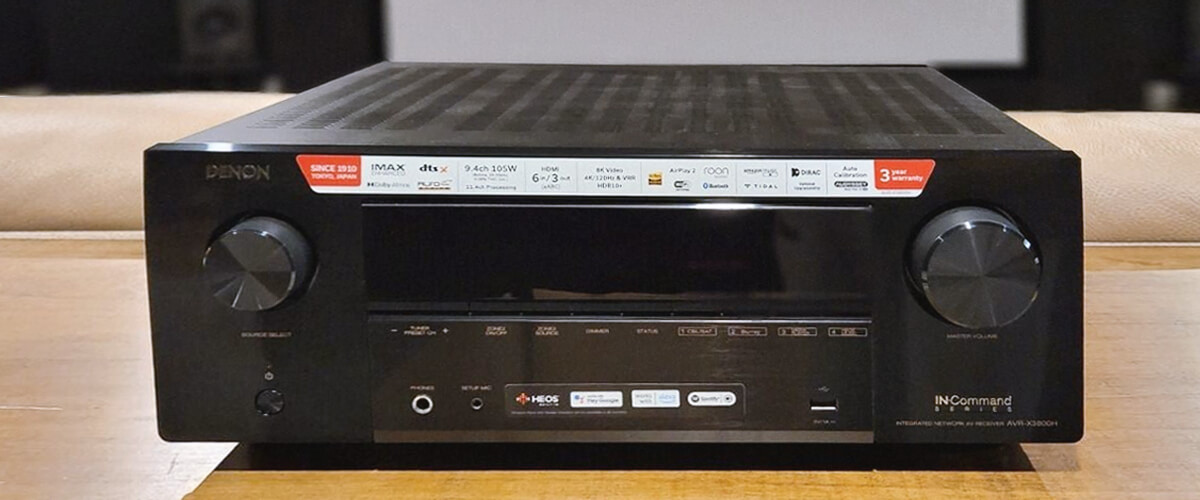
When buying or selecting a receiver, we usually see the numbers 7.1, 9.1, or 11.1, where the first digit means the main speakers and the second digit means the subwoofers. The configuration suitable for Dolby Atmos involves allocating at least two channels from the first digit and moving them to the ceiling. These are called Height channels and distribute the sound from above as if it were coming from there (soaring birds, a passing helicopter, the sound of leaves in the forest, etc.).
Common Dolby Atmos Configurations can be built in this way:
- 5.1.2 (originally 7.1) is the minimum Dolby Atmos system. That is, you add ceiling speakers to a traditional 5.1 system, and you can hear the simplest version of the technology. Good in 150-300 square foot apartments.
- 5.1.4 (9.1) gives a deeper experience because it uses 4 ceiling speakers already.
- 7.1.2 (also 9.1). You add 2 rear and 2 ceiling channels that create a surround picture and put the viewer in the center of the action.
- 7.1.4 and 9.1.4 (or 11.1 and 13.1) are optimal because they are suitable for large living rooms and fully comply with Dolby Atmos requirements in the home.
- 9.1.4 (15.1) is the most suitable for specialized mini-cinema, advanced (commercial) systems. You can guess that the viewer gets the most accurate realization of the Atmos sound range.
Real full-fledged cinemas use a much larger number of speakers.

